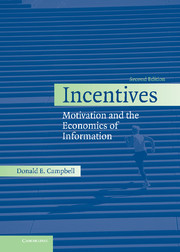Book contents
- Frontmatter
- Contents
- Preface to the Second Edition
- 1 Equilibrium, Efficiency, and Asymmetric Information
- 2 Basic Models and Tools
- 3 Hidden Action
- 4 Corporate Governance
- 5 Hidden Characteristics
- 6 Auctions
- 7 Voting and Preference Revelation
- 8 Public Goods and Preference Revelation
- 9 Matching
- 10 General Competitive Equilibrium
- References
- Author Index
- Subject Index
9 - Matching
- Frontmatter
- Contents
- Preface to the Second Edition
- 1 Equilibrium, Efficiency, and Asymmetric Information
- 2 Basic Models and Tools
- 3 Hidden Action
- 4 Corporate Governance
- 5 Hidden Characteristics
- 6 Auctions
- 7 Voting and Preference Revelation
- 8 Public Goods and Preference Revelation
- 9 Matching
- 10 General Competitive Equilibrium
- References
- Author Index
- Subject Index
Summary
This chapter examines allocation problems for which the scarce resources are available only in discrete units, such as dormitory rooms, and each “consumer” wants one unit and only one unit. The objective is to match students with rooms, or available kidneys with the patients on a waiting list for a transplant, and so forth. The entire family of matching problems can be subdivided in two different ways. We can classify according to the nature of preferences. On one hand, suppose that an economics department has a given number of students (i.e., majors) and professors, and the objective is to assign each student a professor-advisor. In this case both sides of the match have preferences: Students like some professors better than others, and the professors also have preferences over the students. On the other hand, there are matching problems for which only one side of the match has preferences: Students have preferences for dormitory rooms, but the rooms don't have preferences for students. A matching problem for which only one side has preferences is referred to as an assignment problem. The objective is to assign students to rooms, for instance.
The other way to classify matching problems is according to whether we can have an outcome in which some agent is matched more than once. In the case of college admissions, each student will be matched with at most one college, but each college is matched with more than one student.
- Type
- Chapter
- Information
- IncentivesMotivation and the Economics of Information, pp. 467 - 512Publisher: Cambridge University PressPrint publication year: 2006

